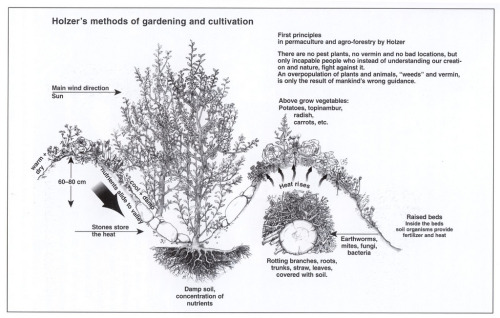#fertilizer
Hügelkultur (German, meaning “hill culture” or “mound culture”) is the garden concept of building raised beds over decaying wood piles. Decayed timbers become porous and retain moisture while releasing nutrients into the soil that, in turn, promote root growth in plant materials. As the logs decay, they expand and contract, creating air pockets that assist in aerating the soil, allowing roots to easily penetrate the soil. This decaying environment creates a beneficial home to earthworms. As the worms burrow into the soil, they loosen the soil and deposit nutrient-rich worm castings, beneficial to plants. An earthworm can produce its weight in castings on a daily basis.
The best decayed wood for a Hügelkultur, according to A Growing Culture, comes from alders, applewood, cottonwood, poplar, maple and birch. Use wood products that have been in the process of decay for about a year (using green, or fresh, wood products will rob the soil of necessary nitrogen). Some wood products, like cedar and black walnut, should be avoided because they produce organisms that negatively effect plant growth.
Read more at A Growing Culture.
Post link
PEST CONTROL FOR BEGINNER GARDENERS: Prevent Unwanted Bugs
=======NOTHING FOR SALE=======18/21+ Adult Information and Entertainment
This channel and its content are 18+ intended for adult users under Bill C-45. I do not condone any illegal activities or encourage use and this video was filmed for educational and documentary purposes only.My one and only guide to the best pest prevention…
COMPREHENSIVE GUIDE TO GROWING WEED: THE VEG & FLOWER CYCLE
=======NOTHING FOR SALE=======18/21+ Adult Information and Entertainment
This channel and its content are 18+ intended for adult users under Bill C-45. I do not condone any illegal activities and this video was filmed for educational and documentary purposes only.A comprehensive gardening guide through the veg and flower cycles…
Yard fertilizing includes feeding it with nutrients necessary for promoting development and providing strength. Property owners can work with a professional service to fertilize their lawn or they can do it themselves. In any case, it is very important to understand how typically to fertilize and what products to use.
Fertilize four times per year in order to have the healthiest yard. Those residing in the northern states need to apply fertilizer a minimum of 2 times annually, once each in spring and fall. The southern states have a longer growing season, so house owners will need to fertilize 2 times each during the spring and fall.
The fall feeding is important because this is when grass experiences root growth, developing strength to hold up against the winter season and following year. Garden stores carry granular or liquid fertilizer items particularly intended to be used during the fall season. These products are typically labeled as winterizers and their components stimulate energetic root growth.
Multi-purpose weed killer and fertilizer can have its pace to in lawn care and upkeep. There is, however, one concern with these in that they do include some pesticides. These pesticides can be taken in into the ground and in turn go into the water supply causing health issues in people. Its use needs to be very little and extremely judicious.
By going green with lawn fertilizer, many homeowners have made the switch to natural fertilizers and weed controllers for their lawns. These have no damaging chemical ingredients to hurt the environment or anything around them. They are also proven to last longer by launching their active ingredients at a much slower rate than that of manufactured fertilizers.
A natural alternative lawn fertilizing method is to rake an inch of compost on top of the lawn. The compost will provide the roots with the nutrients needed to stimulate growth. Leaving lawn clippings on the yard or using a mulch mover will also provide the yard with much-needed nitrogen.




